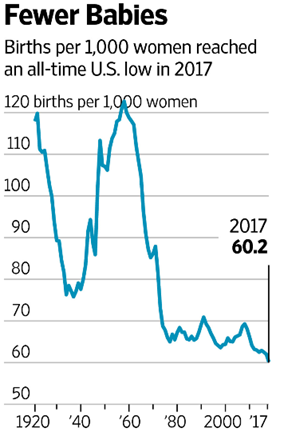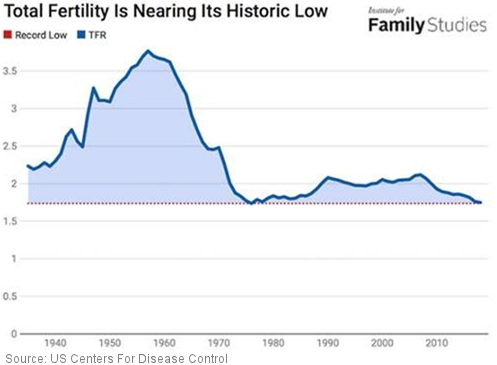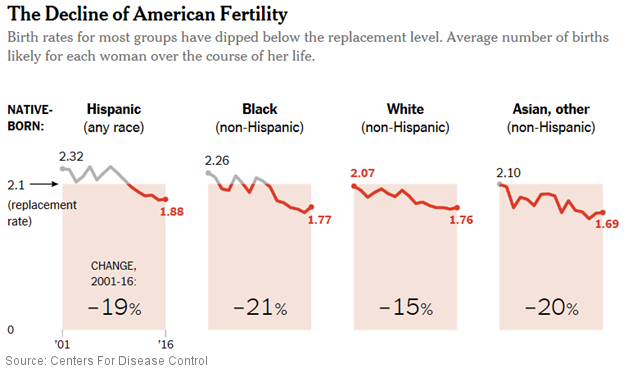FORECASTS & TRENDS E-LETTER
by Gary D. Halbert
May 29, 2018
1. US Birthrate Falls to 30-Year Low in 2017
2. Is the Drop in Fertility a Temporary Phenomenon?
3. Birthrates Decline For Almost All American Age Groups
4. Conclusions & Solutions – No Easy Way Out
Q1 hedge fund letters, conference, scoops etc, Also read Lear Capital: Financial Products You Should Avoid?
Overview
The government reported earlier this month that the US birthrate fell to the lowest level since 1987 last year, despite an increase in the number of child-bearing age women in the population since then. The government also reported that the “fertility rate” – the number of births per 1,000 women – fell to the lowest level in almost a century in 2017.
This might seem like an odd topic to write about in an investment/economic E-Letter, but there are important implications for the economy, the workplace and the financial markets should these trends continue. For that reason, I would like all of my clients and readers to understand these implications and how they might affect our lives, our standard of living and maybe even our investments in the future.
US Birthrate Falls to 30-Year Low in 2017
American women are having children at the lowest rate on record, with the number of babies born in the US last year dropping to a 30-year low, according to a new government report released earlier this month.
Only 3.85 million babies were born last year, down 2% from 2016 and the lowest number in three decades, according to the US Centers for Disease Control (CDC).
The overall fertility rate for women age 15 to 44 was 60.2 births per 1,000 women – the lowest rate since the government began tracking it almost a century ago, according to the CDC.
Put differently, the total fertility rate among women of child-bearing age (15-44) fell to only 1.76 births per woman in 2017, the lowest level since 1978.
The “replacement rate” – the number of births per women of child-bearing age – to keep the population steady is 2.1 births.
The figures suggest that a large number of women who put off having babies after the 2007-09 recession are forgoing them altogether. It is estimated that 4.8 million fewer babies were born after the recession than would have been born had fertility rates stayed at pre-recession levels.
This decline in the birth rate will exacerbate the problems of America’s aging population. Many Baby Boomers are in or near retirement, leaving a smaller share of younger workers to pay into Social Security and Medicare. That is creating a funding imbalance that will strain the social safety net that supports the elderly.
While pundits continue to debate the causes of the long-term drop in fertility – which include economic worries among Millennials, lifestyle preferences for increasingly well-educated young women and a downward trend in Hispanic family size – the implications for social safety net programs that rely on younger workers funding benefits for older citizens are significant.
Is the Drop in Fertility a Temporary Phenomenon?
The latest actuarial report from the Trustees of Social Security assumes that the recent drop in the fertility rate has been driven by the lingering effects of the recession of 2007-09 and therefore should be temporary. The Trustees assume that the fertility rate will rise as the economy strengthens, reaching 2.05 by 2023, then dropping slightly to 2.0 by 2027.
Yet the latest data suggests that an improving economy may not produce the expected increase in the fertility rate from current levels, leaving the US below the replacement rate of 2.1 on a long-term and perhaps permanent basis.
Beyond the baseline projection noted above, the Social Security Trustees considered other paths for population growth, including a scenario in which the fertility rate only rebounds to only 1.80. In that scenario, the smaller number of workers paying into the system over many decades means that the gap between revenues and outlays grows even larger than currently projected.
While there’s little doubt that fewer births will put a strain on the American social safety net, the most often cited solutions to the problems produced by dropping fertility rates are higher payroll taxes and increased immigration. The latest demographic data serve as a warning that those political solutions will likely have to be debated and implemented at some point.
Birthrates Decline For Almost All American Age Groups
The post-recession baby lull appeared to be ending when births ticked up in 2014. But they’ve now fallen for three straight years, and last year’s fertility-rate drop was the largest one-year decline since 2010.
Even women in their 30s – the group that had increasingly carried America’s childbearing in recent years – saw their fertility rate decrease in 2017. For women age 30 to 34, there were 100.3 births per 1,000 women, down 2% from the prior year. Among women age 35 to 39, the birthrate was 52.2 births per 1,000 women, down 1% from 2016.
The only age group that had babies at a higher rate in 2017 was women in their early 40s, with those age 40 to 44 having 11.6 births per 1,000 women, up 2% from the prior year. This is largely a function of women working longer and delaying having children.
The decline in the fertility rate also stretches across racial lines, as you can see below. Birth rates have declined sharply across almost all racial groups since 2014.
One bright spot in the latest CDC report is the continued sharp decline in teen births, which fell 7% last year. Since 2007, the teen birthrate has declined by 55% and is down 70% since its peak in 1991. That’s good news. Children born to adolescents are more likely to have poorer educational, behavioral and health outcomes throughout their life.
Conclusions & Solutions – No Easy Way Out
As noted above, American women are having fewer babies than at any time in the last 30 years, despite a significant increase in the population. Only 3.85 million birth certificates were issued last year, down 2% from 2016 and the lowest since 1987. The fertility rate sank to 60.2 births per 1,000 women aged 15 to 44, the lowest since records have been kept for almost a century.
What these numbers mean for the US population is that the country won’t be able to achieve a viable replacement rate – the standard for any given generation to replicate its total. A country’s birthrate is among the most important measures of demographic health. If too low, there’s a danger that we wouldn’t be able to replace the aging workforce and have enough tax revenue to keep the economy stable.
The Millennial generation – currently at peak reproduction age – is partly to blame because of their shifting attitudes away from parenting, according to the CDC report. As a result, they are more likely to put off having kids and are growing their families in smaller numbers than their parents and grandparents.
The CDC also noted that the use of contraceptives – like intra-uterine devices (IUDs) – specifically made for long-term use are on the rise. The increase in women attending college is another force behind the birth decline, researchers say. Those with more skills face a greater trade-off if they interrupt their careers to have children.
The US has been living through one of the longest declines in fertility in decades and demographers are trying to figure out what is driving it. Fertility rates tend to drop during difficult economic times as people put off having babies, and then rise once the economy rebounds. Yet this time the rate has not recovered since the Great Recession.
What makes this downward trend harder to comprehend is the overall population of women of prime childbearing age is significantly greater than it was a decade ago, with there being 7% more women aged 20 to 39 in 2017 than there were in 2007.
If the decline in fertility continues unabated, it will have profound implications for the US economy of the future – as the low baby population of today will be the workers of tomorrow. And if their numbers don’t bounce back sometime soon, neither will the future US workforce.
After decades in which the US enjoyed a relatively high fertility rate when compared with that of other developed countries, we are approaching a major problem if this trend continues. While the US birthrate is still above countries such as Spain, Greece, Japan and Italy, the gap appears to be closing.
At the end of the day, America’s population growth will increasingly depend on immigrants. And as you know, that’s a controversial topic these days. I’ll leave it there for today.
All the best,
Gary D. Halbert
SPECIAL ARTICLES
As Population Growth Slows, Populism Surges
Gary’s Between the Lines Blog: One-Third of Adults Have Less Than $5,000 Saved



